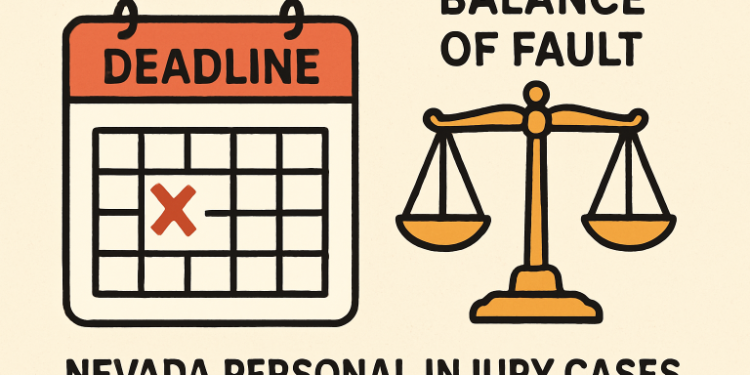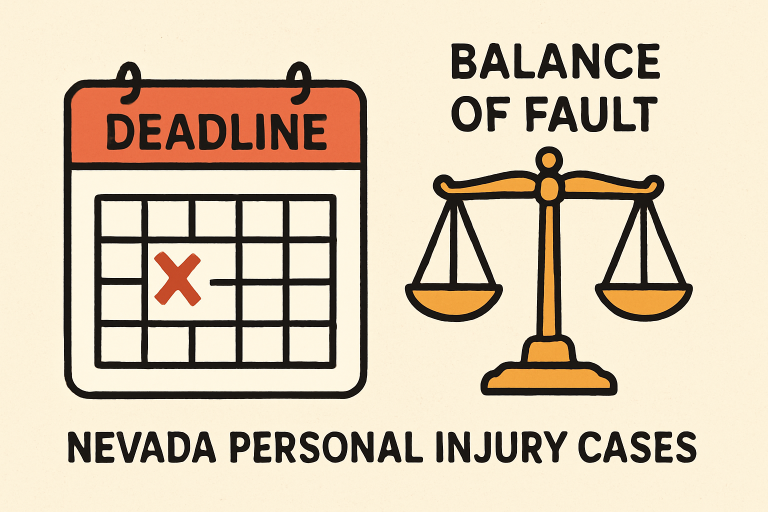Understanding Nevada’s Personal Injury Laws

Anyone considering a personal injury claim in Nevada must navigate a unique legal landscape shaped by state-specific statutes, procedural requirements, and recent legislative updates. Whether you’ve been injured in a car accident, a slip-and-fall incident, or another type of accident, understanding these rules is crucial for protecting your rights and maximizing your chances of receiving fair compensation. If you are unsure how Nevada law applies to your situation, consulting a Las Vegas personal injury lawyer can be essential in helping you understand your legal options.
Nevada’s personal injury laws are designed to balance the interests of injured parties and defendants through specific deadlines, comparative fault standards, and mandatory insurance requirements. Staying aware of these laws not only helps claimants take timely action but can also significantly impact the amount of compensation recovered. Recent regulatory changes have introduced important updates that every claimant should be aware of before filing a lawsuit.
Table of Contents
Statute of Limitations
Under Nevada law, the statute of limitations for most personal injury cases is two years from the date of the injury. This means that, generally, you must file your lawsuit within this period, or you will lose your right to seek judicial redress. However, exceptions exist—such as when claims involve government agencies, which often require significantly shorter notice and filing timelines. These nuances can make the difference between a valid claim and one that is barred.
The importance of acting promptly in Nevada personal injury litigation cannot be overstated. Besides strict legal cut-off dates, prompt evidence collection and documentation can strengthen your case, especially when witness memories fade and physical evidence is lost over time.
Comparative Negligence
Nevada employs a modified comparative negligence doctrine. Here, the percentage of fault assigned to the plaintiff directly impacts how much—if any—damages can be claimed. If you are less than 50% at fault, your damages are reduced proportionally. For example, if you are found 20% at fault and have $100,000 in damages, you may recover $80,000. However, should you be 50% or more responsible, Nevada law bars you from recovering any damages, regardless of the actual injury or loss.
Proving the other party’s higher degree of fault is critical. Document every aspect of the incident—from police reports and accident scene photographs to consistent medical records. Such diligence can be pivotal in maximizing your eventual recovery.

Burden of Proof
In civil litigation, including personal injury claims in Nevada, the “burden of proof” rests on the plaintiff. You must demonstrate—by a preponderance of the evidence—that the defendant’s negligence caused your injuries. This threshold means showing it is more likely than not (over 50%) that the defendant’s actions led to your losses. Key evidence often includes medical reports, accident photos, repair bills, and credible witness statements, all of which help substantiate the link between the incident and injury.
Damages Available
The damages available in Nevada personal injury cases are divided into three main categories:
- Economic Damages: These cover easily quantifiable losses, such as hospital bills, lost wages, rehabilitation expenses, and the cost of necessary future medical care.
- Non-Economic Damages: Compensation for pain and suffering, emotional trauma, loss of enjoyment of life, and loss of consortium. These losses are real, yet more challenging to calculate.
- Punitive Damages: In rare cases where the defendant’s conduct is shown to be especially reckless or malicious, punitive damages may be awarded to punish the wrongdoer and deter similar conduct in the future.
Understanding your potential recovery and the types of damages for which you may be eligible can help set realistic expectations as your case progresses.
Insurance Requirements
Nevada law requires vehicle owners to maintain minimum liability insurance, which acts as a vital source of compensation for those injured in motor vehicle accidents. The minimum required coverage levels are $25,000 per person for bodily injury, $50,000 per accident for multiple injuries, and $20,000 per accident for property damage. These monetary amounts define the minimum that must be available to cover damages if a policyholder is found at fault in an accident, helping ensure that injured parties have access to critical funds when seeking compensation.
Recent Legislative Changes
Nevada’s personal injury laws have seen notable changes in recent years—some of which directly alter how and when cases can be brought:
- Clarification of Comparative Negligence: The law now specifies with more certainty that claimants cannot recover damages if found to be 50% or more at fault.
- Shortened Statutes for Government Cases: For injuries involving public entities, notice requirements and limitation periods are now shorter than the general two-year rule.
- Increased Insurance Minimums: New legislation has raised the minimum amounts required for automobile liability insurance, increasing protections for accident victims statewide.
Staying up-to-date with recent legal changes is crucial, since these legislative shifts may directly affect the outcome or viability of a claim.
Pre-Litigation Requirements
In an effort to streamline the resolution of personal injury cases and reduce court congestion, Nevada has added pre-litigation steps in some types of civil cases. These measures may include mandatory mediation, arbitration, or other forms of alternative dispute resolution (ADR) before the case proceeds to trial. These processes not only help resolve claims more efficiently but also often lead to settlements without the necessity of prolonged litigation.
Conclusion
Nevada’s personal injury legal landscape is dynamic, and understanding its statutes, requirements, and procedures can make a significant difference in your ability to recover after an accident. Knowing the statute of limitations, how comparative negligence can be applied, and the recent legislative updates are all key to navigating your claim effectively. Should you find yourself or a loved one injured, seeking advice from a knowledgeable attorney will help ensure that your rights are fully protected and that you’re taking the proper steps toward a successful recovery.





